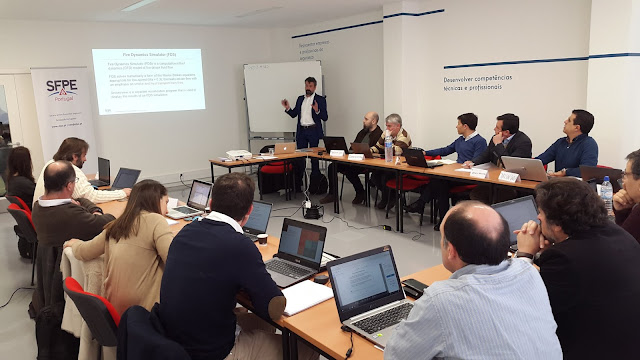11th SFPE Conference on Performance-Based Codes and Fire Safety Design Methods, Warsaw
Back
from Warsaw after quite a hectic week, starting on Sunday with the ECCG meeting
(European Chapters Coordination Group) invited to attend the Board of Directors
meeting.
It
was a great conference, with new ideas to be implemented in our day-to-day work
and other to be developed for future applications.
I am very proud of the JVVA involvement
in the 11th SFPE PBD Conference held in Warsaw this week. My colleague Olaf
Perez, Fire Engineer at JVVA, presented the paper "Sensitivity
Analysis for Modelling Parameters Used for Advanced Evacuation Simulations –
How Important Are the Modelling Parameters When Conducting Evacuation
Modelling?", Jimmy Jönsson presented the Spanish case study on Industrial
Buildings and I presented the paper "Influence of Variability of Soot
Yield Parameter in assessing the safe conditions in Advanced Modelling
Analysis. Results of Physical and Numerical Modelling Comparison” together
with Wojciech Wegrzynski,
Head of Smoke Control, Signalling and Fire Automation Division at the
Building Research Institute (ITB) of Poland.
I
have had also the pleasure of moderating the Smoke session and being part of
the panel for the Shopping mall case study.
I
want to spend a few lines describing what was my paper was about. It
is a research exercise and thus a work in progress one, but I
think it could be already quite useful.
During
this year we performed several experimental tests in the ITB Research Centre of Warsaw, Poland,
using different fuels with a wide range of soot yield (from 0.001 g/g fort
Methanol to 0.178 g/g for Toluene). The results have been compared to numerical
models processed with both Ansys Fluent and Fire
Dynamics Simulator. The results showed good agreement for Heptane and thus
this fuel was used as a base for a numerical study looking at 20 different
cases, each one with a soot yield difference of 0.01 g/g (from 0.01 g/g to 0.20
g/g).
The numerical analysis,
both for Ansys Fluent and FDS, show an hyperbolic trend of the Visibility when
increasing the soot yield with a cut-off point around 0.12 g/g where a
variation of the soot yield can produce a relevant (below 0.12 g/g) or a
negligible (above 0.12 g/g) change in the Visibility.
Based on the numerical
analysis performed, for the same fire scenario, the following value of
visibility has been calculated from the models:
Soot Yield (g/g)
|
0.01
|
0.02
|
0.03
|
0.04
|
0.05
|
0.06
|
0.07
|
0.08
|
0.09
|
0.10
|
Visibility (m) – FDS*
|
14.87
|
10.90
|
7.34
|
5.39
|
4.29
|
3.55
|
2.98
|
2.60
|
2.31
|
2.06
|
Visibility (m) – Fluent*
|
15.15
|
7.64
|
4.91
|
4.04
|
2.96
|
2.44
|
2.12
|
1.90
|
1.62
|
1.48
|
Soot Yield (g/g)
|
0.11
|
0.12
|
0.13
|
0.14
|
0.15
|
0.16
|
0.17
|
0.18
|
0.19
|
0.20
|
Visibility (m) – FDS*
|
1.85
|
1.71
|
1.56
|
1.43
|
1.31
|
1.21
|
1.14
|
1.07
|
1.00
|
0.94
|
Visibility (m) – Fluent*
|
1.34
|
1.30
|
1.23
|
1.09
|
1.02
|
N/A
|
0.91
|
0.849
|
0.82
|
0.74
|
*Value for reflecting
signs
As can be seen in the
table using a chemical reaction with a soot yield value of 0.02 g/g the
Visibility (for reflecting signs) would be about 10m, whilst with a soot yield
value of 0.04 g/g, the Visibility (for reflecting signs) would be about 5m and
with a soot yield of 0.10 g/g, the Visibility (for reflecting signs) would be
about 2m. This means that for the same fire scenario the implications of
choosing a reaction instead of another can lead to a huge over prediction of
the Visibility and therefore a huge under estimation of the Fire Safety.
One of the main
conclusions of this study is that unless the materials (and thus the chemical
reactions) in the building to be assessed by a Fire Engineering analysis are
well known, value of soot yield below about 0.10 g/g should be used with
extremely caution when performing an ASET/RSET exercise.
Although
the overall conclusions still be valid, more accurate experiments will be
performed in order to better understand the deviation from the numerical
results.
Thanks to Charles
Fleischmann, Professor at the University of Canterbury, New Zealand, for
the interesting comments and the new ideas provided.
I hope you enjoy the
presentation.




Comments
Post a Comment